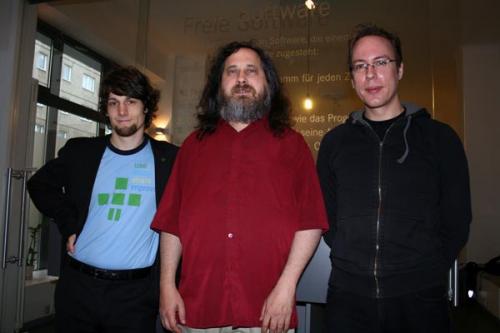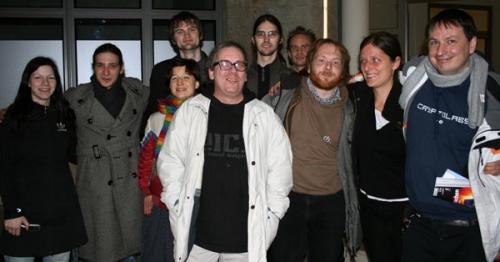At the CeBIT I had the chance to talk to some fantastic folks of direct open embedded systems, a new Latvian company that is producing WLAN devices based on the GNU/Linux distributions like OpenWRT, OpenEmbedded and FlashSYS Linux.
In the video they present their devices and some show cases as well as FlashSYS, their own web based firmware for small router computers.
FlashSYS environment is a cross-operating system clent-server environment that allows developers to use existing web development skills (HTML, JavaScript, Ajax, Flash, SQLite, and Lua) to build and deploy Rich Internet Applications (RIA) for an embedded system with a very small footprint. (http://openrb.com)
direct open embedded systems is able to produce WLAN devices that can act as small web servers with currently up to 64 GB storage space.
Most of the free and open source companies presented their products in hall 5, which was packed with crowds of people. You can get an idea when you hear the background noise in the video. The interest in free and open source technologies is amazing and ever increasing.
Some more specifications of the router devices:
-
Bittorent, FTP, HTTP download clients included. Now you don’t have to leave your computer on to complete your downloads, they can be easily stored on a Compact Flash card (up to 64GB) or on external USB Flash / hard disk
-
Network OS with AJAX user interface
-
Integrated organizer with Calendar, To-do and Notes
-
RSS feed reader
-
LCD screen for displaying news, notes and current activities
-
P2P streaming media server for video and audio
-
Very rich network functionality (QoS, tunnels, routing, firewall, NAT, etc.)
Extendable
-
PCI bus for wireless interfaces, video, Ethernet and other miniPCI devices
-
I2C bus for serial memory, A/D and D/A converters, temperature/voltage monitors
-
RS232/RS485 for keyboard, LCD and other devices for industrial applications
-
USB host with two ports for various serial devices from flash disks to web cameras
-
GPIO for relays, LEDs, etc.
Memory
-
RAM: up to 512 MB
-
Flash: 8 MB on-board, extendable up to 64 GB using CompactFlash
Green and energy saving
-
Fully ROHS compliant
-
Processor power consumption (typical): 0.72 W at 266 MHz
Stable
-
Hardware watchdog timer
-
Industrial temperature grade
-
ESD protected Ethernet and power ports
-
Reliable tantalum capacitors on board except for only one electrolytic cap
Software ported to
-
OpenEmbedded Linux
-
OpenWRT Linux
-
FlashSYS Linux with revolutionary AJAX interface
-
eCOS Real Time operating system
Created for
-
Wireless and wired router solutions
-
Machine2Machine (M2M) applications
-
Industrial applications
-
Home wireless AP and media servers
-
Automation devices
Wireless
-
Chipset Atheros AR5414
-
IEEE Standards 802.11a/b/g (2.4/5 GHz)
-
Security Hardware 64 and 128 bit WEP; Hardware TKIP and AES-CCM encryption; WPA authentication
-
Bandwidth up to 108 Mbps
-
Modulation OFDM, TDD
Technical details
-
PowerPC processor: 266 or 333 MHz clock frequency
-
1 or 2 ESD protected Ethernet ports
-
miniPCI sockets for 802.11 wireless cards and other expansion
-
32-512 MB SDRAM, 64 bit wide for high memory bandwidth
-
8 MB FLASH for system BIOS and programs
-
True IDE CompactFlash (CF) header for custom OS and applications
-
7 to 36 V DC supply through DC jack or passive power over LAN connector
-
2 RS232 serials ports (1 DB9 male socket), RS485 interface header
-
JTAG interface header
-
Hardware and software watchdog timers
-
LM75 thermal monitor
-
GPIO header
-
USB 2.0 host
-
I2C bus header (can be used for front panel interface)
-
2 LEDs and 1 pushbutton switch, freely programmable
-
Board size: 115 mm x 97 mm
-
CE certified

